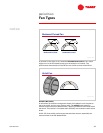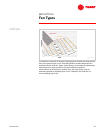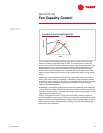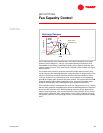
TRG-TRC013-EN 41
period three
Fan Capacity Control
notes
This method of fan modulation can be used with any type of fan. It is most
effective, however, when applied to FC fans. The configuration of the input
power curves of the FC fan are such that its power requirement drops as the fan
operating point moves upward along the constant-speed performance curve.
Recall that the input power curves of the BI, AF, and vaneaxial fans closely
parallel the fan performance curves. Therefore, the power reduction of these
types of nonoverloading fans would not be as significant when “riding the fan
curve.”
Additionally, when the BI and AF fans surge, undesirable noise and vibration
result. Care must be taken to establish a modulating range that does not take
these fans into the surge area. The FC fan, on the other hand, may be operated
in the surge area, provided the operating point enters the surge area at a
relatively low static pressure.
A satisfactory modulation range may be achieved by selecting a fan that is two
to three sizes (fan wheel diameter) smaller than one that would be selected for
a constant-volume system. This places the design operating point farther to the
right on the performance curve.
Finally, “riding the fan curve” is used most successfully when the system’s
airflow modulation range is small. If the fan is required to modulate over a wide
range of airflows, the increased static pressure experienced at reduced airflow
may overpressurize the VAV terminals, resulting in greater-than-desired space
airflow and noise problems.
Forward Curved Centrifugal Fan
$
%
airflow
airflow
static pressure
static pressure
input power
input power
Figure 62


















